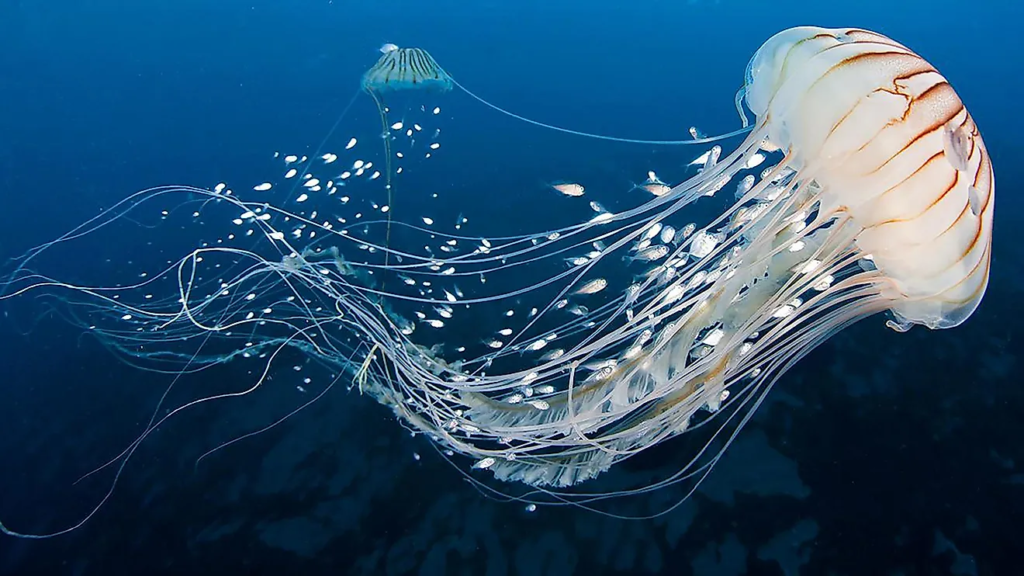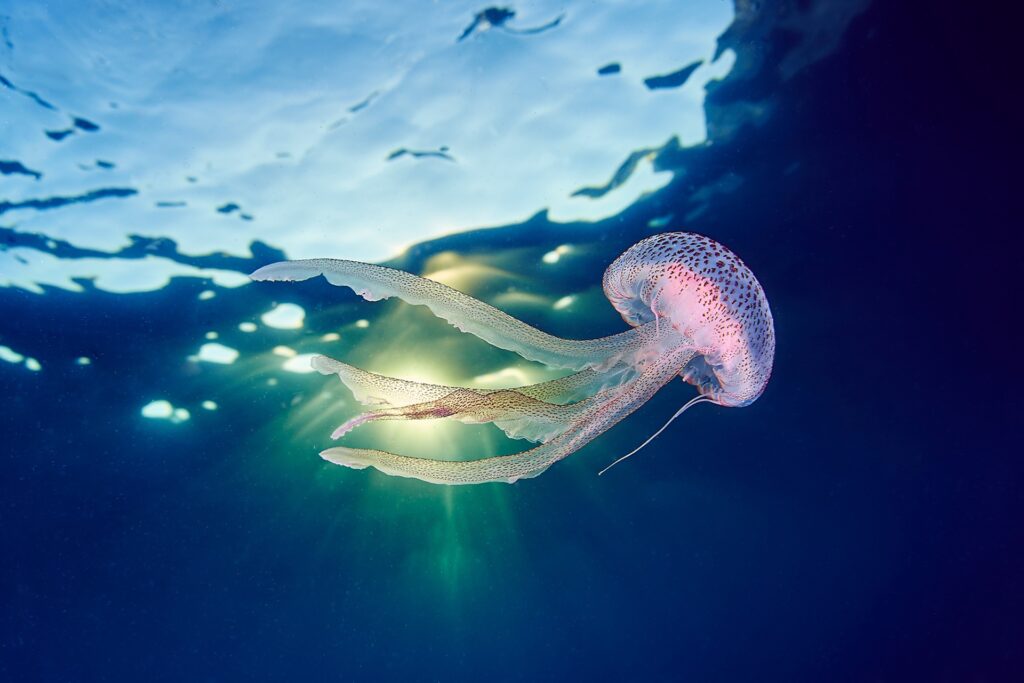Table of Contents
ToggleIntroduction

Jellyfish, those mesmerizing ocean creatures, belong to the phylum Cnidaria and are known for their delicate, gelatinous bodies and graceful, undulating movements. These fascinating organisms have captured the attention of scientists, artists, and beachgoers alike due to their unique appearance and intriguing behaviors.
Physical Characteristics
Jellyfish exhibit diverse physical characteristics, with various species displaying unique environmental adaptations. However, they all share certain fundamental features that define their appearance. Here are the key physical attributes of jellyfish:
Bell (Medusa): The bell is the jellyfish’s umbrella-like, usually translucent, main body. It is composed of a soft, gelatinous substance called mesoglea, which gives the jellyfish its characteristic gel-like appearance. The bell’s shape and size vary significantly among different species, from flattened and saucer-like to more elongated or rounded.
Tentacles: Hanging from the underside of the bell are long, slender, and often trailing tentacles. Cnidocytes line the tentacles, and inside them are nematocysts, which resemble miniature harpoons packed with poison. Nematocysts are sacs that, when activated, blast out and inject venom into prey or prospective threats to immobilize or scare them away.
Oral Arms: Many species of jellyfish have structures called oral arms that extend from the center of the underside of the bell. These arms aid in capturing and transporting food to the jellyfish’s mouth. The mouth is located on the bottom of the bell and serves as both an entry point for prey and an exit for waste.
Gonads: Jellyfish have reproductive organs called gonads that produce eggs or sperm. Depending on the species, these gonads can happen upon various parts of the jellyfish’s body, such as the inner surface of the bell or the oral arms.
Nerve Net: While jellyfish lack a centralized brain, they possess a nerve net, a decentralized network of interconnected nerve cells. This nerve net allows for essential sensory perception, coordination of movements, and responses to stimuli.
Bioluminescence (in Some Species): Certain species of jellyfish are bioluminescent, meaning they can produce their own light. Phagocytes are specialized cells that produce bioluminescence through chemical reactions. It can help an animal attract prey, trick a predator, and even help it communicate with others of its species.
Transparency and Color: Many jellyfish are nearly transparent, allowing light to pass through their bodies. This transparency often aids in camouflage and protection from predators. However, some species exhibit vibrant colors, usually from pigments within their tissues or symbiotic relationships with other organisms.
Mucous Layer: Some species of jellyfish have a protective mucous layer covering their bell. This layer can help deter potential predators and provide a barrier against specific environmental conditions.
Life Cycle Of Jellyfish
The jellyfish life cycle involves two main stages: the medusa stage and the polyp stage. The medusa stage is the well-known free-swimming adult form that most people recognize. However, jellyfish start as tiny, attached polyps. Polyps settle on surfaces such as rocks or the sea floor, and they can reproduce asexually by budding to create identical clones of themselves.
When conditions are right, polyps can also produce small, planktonic structures called ephyrae, which eventually develop into the mature medusa form. The medusae then release eggs and sperm into the water, where fertilization occurs, developing new polyps.
Feeding and Predation:
Jellyfish are primarily carnivorous, using their stinging tentacles to capture prey, including small fish, zooplankton, and other microscopic organisms. When the game comes into contact with their tentacles, the nematocysts fire, injecting venom into the prey and immobilizing it. The tentacles then transport the captured prey to the jellyfish’s mouth, located on the underside of the bell.
Ecological Importance:
The ecological importance of jellyfish extends beyond their enigmatic beauty, as they play a significant role in marine ecosystems. Despite their sometimes negative reputation due to their occasional population explosions known as blooms, jellyfish serve several crucial functions that contribute to the health and balance of the oceans:
Predator-Prey Dynamics: Jellyfish are predators and prey, participating in complex food webs. They feed on zooplankton and small fish, helping to control the populations of these organisms. Additionally, jellyfish are a food source for marine animals, such as sea turtles, specific fish species, and seabirds. Their abundance influences the populations of these predators and can affect overall ecosystem dynamics.
Nutrient Cycling: When jellyfish consume their prey, they release nutrients like carbon, nitrogen, and phosphorus into the water through excretion and waste. These nutrients are then available for other organisms to utilize, contributing to nutrient cycling in the marine environment.
Competition for Resources: Jellyfish can outcompete other zooplankton for resources, leading to shifts in the composition of plankton communities. This competition can have cascading effects throughout the food web, impacting the populations of species at various trophic levels.
Habitat for Juvenile Fish: Some juvenile fish find refuge among the tentacles of jellyfish, using them as a protective cover from predators. This association benefits the fish and the jellyfish, creating a unique ecological niche within the ocean ecosystem.
Vertical Migration: Many jellyfish participate in vertical migration, moving up toward the water’s surface at night to feed and returning to deeper waters during the day to avoid predators. This movement helps transport organic material and nutrients between different ocean layers, aiding in nutrient distribution and promoting mixing within the water column.
Indicators of Ecosystem Health: The presence and abundance of jellyfish can indicate marine ecosystems’ overall health and balance. Their populations can respond to changes in temperature, nutrient availability, and human impacts such as overfishing and pollution. Shifts in jellyfish populations can highlight disruptions in the ecosystem and provide valuable insights for researchers and conservationists.
Carbon Sequestration: When jellyfish die, they sink to the ocean floor, carrying their carbon-rich bodies. This process contributes to carbon sequestration, which plays a role in regulating global carbon cycles.
Although jellyfish play a vital function in the environment, it is crucial to highlight that human activities can also affect the dynamics of their population. Warming temperatures, nutrient pollution, overfishing, and habitat destruction can affect Jellyfish populations and their interactions with other species.
Bloom Phenomenon:
Jellyfish blooms, where vast numbers of these creatures appear in a particular area, are a natural occurrence. However, due to climate change, nutrient pollution, and overfishing, jellyfish blooms have been observed more frequently in certain regions. These blooms can have significant ecological and economic impacts, affecting fisheries, tourism, and marine biodiversity.
Bioluminescence:
Some species of jellyfish are bioluminescent, producing their light through chemical reactions. This adaptation serves various purposes, including attracting prey and confusing predators. When disturbed, these jellyfish can create beautiful light displays in the dark ocean depths.
Conclusion
Jellyfish are captivating organisms that hold a prominent place in marine ecosystems. Their intricate life cycles, stunning appearances, and vital ecological roles make them a subject of ongoing scientific study and a source of wonder for people worldwide. However, it’s essential to recognize the delicate balance of their populations and their vulnerability to environmental changes, as their presence is an indicator of the health of the oceans.







